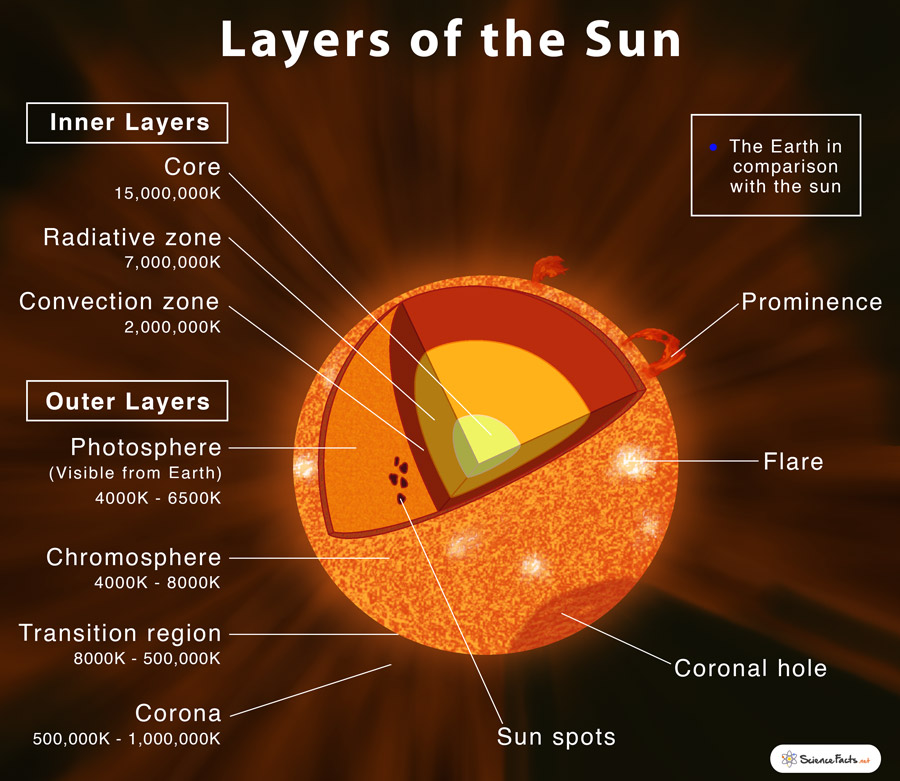What is the Sun Made of
How Many Layers Does the Sun Have, and What are They Called
Inner Layers
Outer layers
Inner Layers
- Core
- Radiative Zone
- Convection Zone Outer Layers
- Photosphere
- Chromosphere
- Transition Region
- Corona
1. Core
Temperature: 15,000,000 Kelvin Density: 150,000 g/cm3 (150 times as dense as water) It is the innermost layer of the sun, which is extremely dense where nuclear fusion generates energy in terms of photons by converting hydrogen into helium. The core is approximately 20% of the size of the solar interior and is found to be the hottest part of the sun.
2. Radiative Zone
Temperature: ∼ 7,000,000 Kelvin Density: ∼ 15,000 kg/m3 Found above the core and is less dense compared to it. It is called the ‘radiative zone’ because it helps to transport the energy generated from the core to other layers of the sun. The high density of matter in this region allows light energy to travel slowly in a zigzag path, encountering particle on its way, thus causing it to change direction and lose some energy. The radiative zone starts at about 25% from the solar surface and extends up to about 70%.
3. Convection Zone
Temperature: ∼ 2,000,000 Kelvin Density: ∼ 150 kg/m3 Found above the radiative zone, it is the last layer of the solar interior. It helps to transport energy from the edge of the radiative zone to the surface through giant convection cells, similar to a pot of boiling oatmeal. The convection zone is a thick layer starting at around 70% from the sun’s radius that gets mixed with the outer surface at the other end (the photosphere).
1. Photosphere
Temperature: 6500 Kelvin at the bottom to 4000 Kelvin at the top Density: 2 × 10−4 kg/m3 It is the deepest layer of the solar atmosphere that we usually see from earth covering a distance of about 400 km from the center of the solar disk. Due to its low density, it is relatively transparent, resulting in the photosphere being regarded as the visual surface of the sun. Practically all the solar energy that reaches the earth is found to be radiated from this layer. It is thus considered the coolest layer of the sun. The photosphere under close observation exhibits a mottled appearance that is called granulation.
2. Chromosphere
Temperature: 4000 Kelvin at the bottom to 8000 Kelvin at the top Density: 5 × 10−6 kg/m3 It is found above the photosphere at a distance between 400 km to 2100 km above the solar surface. The temperature of chromosphere gets hotter as we go further away from the sun. Due to its high temperature hydrogen emits light that gives off a reddish color, known as H-alpha emission.
3. Transition Region
Temperature: 8000 Kelvin at the bottom to 500,000 Kelvin at the top Density: 2 × 10−10 kg/m3 A narrow region covering a thickness of about 100 km between the chromosphere and the next adjacent layer called the corona. The temperature in this region is also found to increase sharply as we move further away from the core and hence the name transition region.
4. Corona
Temperature: 500,000 Kelvin at the bottom to 1,000,000 Kelvin at the top Density: 10−12 kg/m3 It is the outermost layer of the sun’s atmosphere that we normally see during a total solar eclipse. It starts at about 2100 km above the photosphere and has no upper limit as it merges with the sun’s outer atmosphere. It is the hottest part of the solar atmosphere.
